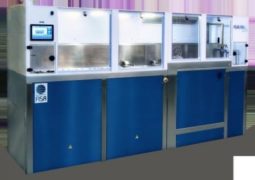COATING, DIP COATING, FLOW COATING : WHAT’S THE DIFFERENCE ?
Dip coating consists of immersing a lens in varnish, which makes it possible to ensure that both sides of the lens have the same properties. As a general rule, applying varnish makes lenses stronger and scratch-resistant.
On the contrary, flow coating aims to differentiate between the two sides of the lens by applying different varnishes depending on the properties that you need. We use robots with a small jet that will only target one single side of the lens. Flow coating is used for certain parts such as ski masks or motorcycle visors because once again we need two different properties on the inside and the outside of the lens. To take the example of the ski mask, we need the inside to be anti-fog while the outside should be particularly scratch-resistant.
FISA MACHINE PROCESSES FOR DIP COATING OR FLOW COATING
DIP COATING: the lenses are put in a basket, cleaned and dried before being immersed in a tank of varnish. The most important thing is to carefully control the speed that the basket is pulled out of the tank so that the varnish is perfectly effective. Once the varnish has been applied to the lens, we have a first drying step to remove the solvent and then we move on to the polymerization phase. Polymerization consists of putting the lenses through an oven to make sure the varnish adheres to the surface of the lens. Some of our machines have an in-line oven to do curing.
FLOW COATING: our robots do the work. They are equipped with small jets to spray only one side of the lens. This varnish then runs down the surface to cover the entire lens. Once the first side has been sprayed, the lens passes through another module for its second coat of varnish. The varnishes used are not the same and they give certain properties to each side of the lens. In order to carry out this surface treatment, our robots need to accurately dose the amount of varnish used, and also carry out very precise movements.
THE FISALABSONE MACHINE IS A SMALL “ALL-IN-ONE” DIP COATING MACHINE
Specially designed for small laboratories, unlike our other machines which are modular, the FisalabsOne is a compact machine with only one module. It can treat up to 90 lenses per hour at a very competitive price. We created this machine because small laboratories do not need high productivity but they have the same quality requirements as the big players. FisalabsOne can carry out all the stages of cleaning and surface treatment up to pre-polymerisation.
If our customer requires higher productivity, he will have to choose one of our modular machines. These machines are capable of producing at least 240 lenses per hour and up to 10,000 lenses per hour depending on the number of modules added.
FISA, 11 October 2019

